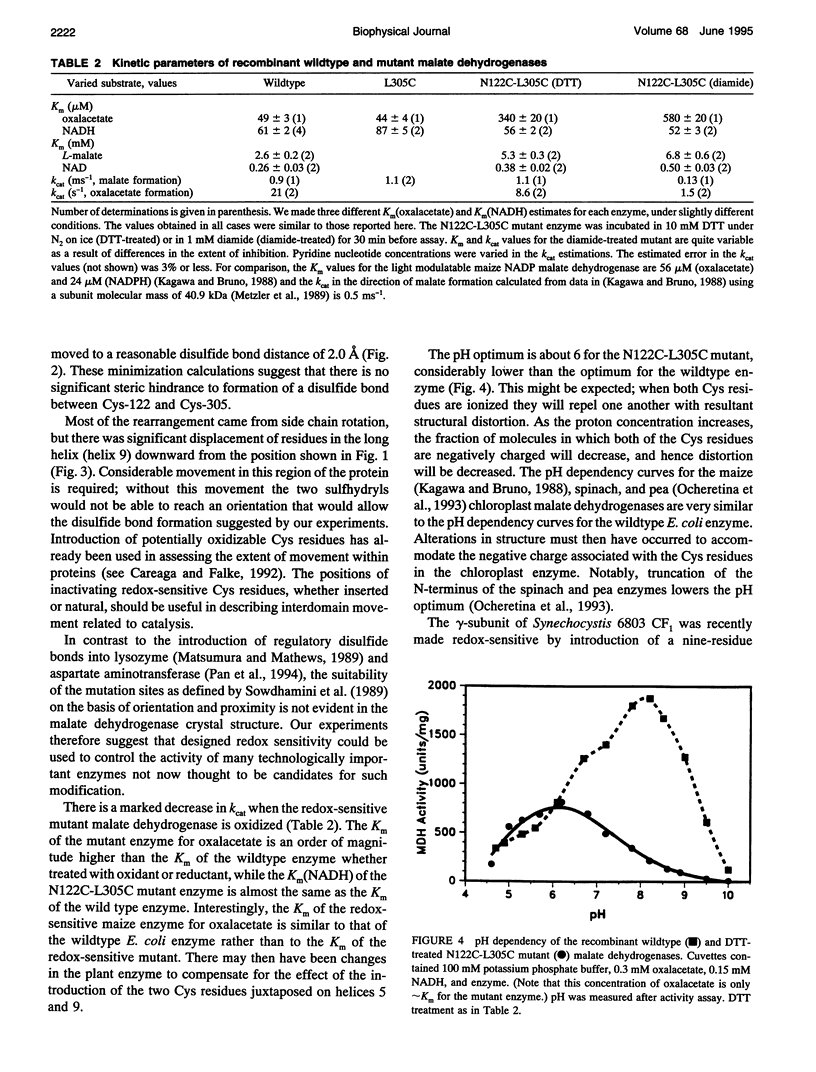Abstract
Light-dependent reduction of cystine disulfide bonds results in activation of several of the enzymes of photosynthetic carbon metabolism within the chloroplast. We have modeled the tertiary structure of four of these light-activated enzymes, namely NADP-linked malate dehydrogenase, glyceraldehyde-3-P dehydrogenase, fructosebisphosphatase, and sedoheptulosebisphosphatase, and identified cysteines in each enzyme that be expected to form inactivating disulfide bonds (Li, D., F. J. Stevens, M. Schiffer, and L. E. Anderson, 1994. Biophys. J. 67:29-35). We have now converted two residues in the Escherichia coli NAD-linked malate dehydrogenase to cysteines and produced a redox-sensitive enzyme. Oxidation of domain-locking cysteine residues in the mutant enzyme clearly mimics dark inactivation of the redox-sensitive chloroplast dehydrogenase. This result is completely consistent with our proposed mechanism.
Full text
PDF





Images in this article
Selected References
These references are in PubMed. This may not be the complete list of references from this article.
- Bradford M. M. A rapid and sensitive method for the quantitation of microgram quantities of protein utilizing the principle of protein-dye binding. Anal Biochem. 1976 May 7;72:248–254. doi: 10.1016/0003-2697(76)90527-3. [DOI] [PubMed] [Google Scholar]
- Buchanan B. B. Regulation of CO2 assimilation in oxygenic photosynthesis: the ferredoxin/thioredoxin system. Perspective on its discovery, present status, and future development. Arch Biochem Biophys. 1991 Jul;288(1):1–9. doi: 10.1016/0003-9861(91)90157-e. [DOI] [PubMed] [Google Scholar]
- Buchanan B. B., Schürmann P., Decottignies P., Lozano R. M. Thioredoxin: a multifunctional regulatory protein with a bright future in technology and medicine. Arch Biochem Biophys. 1994 Nov 1;314(2):257–260. doi: 10.1006/abbi.1994.1439. [DOI] [PubMed] [Google Scholar]
- Careaga C. L., Falke J. J. Structure and dynamics of Escherichia coli chemosensory receptors. Engineered sulfhydryl studies. Biophys J. 1992 Apr;62(1):209–219. doi: 10.1016/S0006-3495(92)81806-4. [DOI] [PMC free article] [PubMed] [Google Scholar]
- Hall M. D., Levitt D. G., Banaszak L. J. Crystal structure of Escherichia coli malate dehydrogenase. A complex of the apoenzyme and citrate at 1.87 A resolution. J Mol Biol. 1992 Aug 5;226(3):867–882. doi: 10.1016/0022-2836(92)90637-y. [DOI] [PubMed] [Google Scholar]
- Hanson K. R., Ling R., Havir E. A computer program for fitting data to the Michaelis-Menten equation. Biochem Biophys Res Commun. 1967 Oct 26;29(2):194–197. doi: 10.1016/0006-291x(67)90586-4. [DOI] [PubMed] [Google Scholar]
- Issakidis E., Decottignies P., Miginiac-Maslow M. A thioredoxin-independent fully active NADP-malate dehydrogenase obtained by site-directed mutagenesis. FEBS Lett. 1993 Apr 19;321(1):55–58. doi: 10.1016/0014-5793(93)80620-a. [DOI] [PubMed] [Google Scholar]
- Issakidis E., Saarinen M., Decottignies P., Jacquot J. P., Crétin C., Gadal P., Miginiac-Maslow M. Identification and characterization of the second regulatory disulfide bridge of recombinant sorghum leaf NADP-malate dehydrogenase. J Biol Chem. 1994 Feb 4;269(5):3511–3517. [PubMed] [Google Scholar]
- Kagawa T., Bruno P. L. NADP-malate dehydrogenase from leaves of Zea mays: purification and physical, chemical, and kinetic properties. Arch Biochem Biophys. 1988 Feb 1;260(2):674–695. doi: 10.1016/0003-9861(88)90497-3. [DOI] [PubMed] [Google Scholar]
- Kunkel T. A., Roberts J. D., Zakour R. A. Rapid and efficient site-specific mutagenesis without phenotypic selection. Methods Enzymol. 1987;154:367–382. doi: 10.1016/0076-6879(87)54085-x. [DOI] [PubMed] [Google Scholar]
- Li D., Stevens F. J., Schiffer M., Anderson L. E. Mechanism of light modulation: identification of potential redox-sensitive cysteines distal to catalytic site in light-activated chloroplast enzymes. Biophys J. 1994 Jul;67(1):29–35. doi: 10.1016/S0006-3495(94)80484-9. [DOI] [PMC free article] [PubMed] [Google Scholar]
- Matsumura M., Matthews B. W. Control of enzyme activity by an engineered disulfide bond. Science. 1989 Feb 10;243(4892):792–794. doi: 10.1126/science.2916125. [DOI] [PubMed] [Google Scholar]
- McAlister-Henn L., Blaber M., Bradshaw R. A., Nisco S. J. Complete nucleotide sequence of the Escherichia coli gene encoding malate dehydrogenase. Nucleic Acids Res. 1987 Jun 25;15(12):4993–4993. doi: 10.1093/nar/15.12.4993. [DOI] [PMC free article] [PubMed] [Google Scholar]
- Ocheretina O., Harnecker J., Rother T., Schmid R., Scheibe R. Effects of N-terminal truncations upon chloroplast NADP-malate dehydrogenases from pea and spinach. Biochim Biophys Acta. 1993 Apr 21;1163(1):10–16. doi: 10.1016/0167-4838(93)90272-s. [DOI] [PubMed] [Google Scholar]
- Pan P., Jakob C. A., Sandmeier E., Christen P., Gehring H. Modulation of the activity of mitochondrial aspartate aminotransferase H352C by the redox state of the engineered interdomain disulfide bond. J Biol Chem. 1994 Oct 14;269(41):25432–25436. [PubMed] [Google Scholar]
- Reng W., Riessland R., Scheibe R., Jaenicke R. Cloning, site-specific mutagenesis, expression and characterization of full-length chloroplast NADP-malate dehydrogenase from Pisum sativum. Eur J Biochem. 1993 Oct 1;217(1):189–197. doi: 10.1111/j.1432-1033.1993.tb18233.x. [DOI] [PubMed] [Google Scholar]
- Scheibe R. Redox-modulation of chloroplast enzymes : a common principle for individual control. Plant Physiol. 1991 May;96(1):1–3. doi: 10.1104/pp.96.1.1. [DOI] [PMC free article] [PubMed] [Google Scholar]
- Skerra A., Pfitzinger I., Plückthun A. The functional expression of antibody Fv fragments in Escherichia coli: improved vectors and a generally applicable purification technique. Biotechnology (N Y) 1991 Mar;9(3):273–278. doi: 10.1038/nbt0391-273. [DOI] [PubMed] [Google Scholar]
- Skrukrud C. L., Gordon I. M., Dorwin S., Yuan X. H., Johansson G., Anderson L. E. Purification and characterization of pea chloroplastic phosphoriboisomerase. Plant Physiol. 1991 Oct;97(2):730–735. doi: 10.1104/pp.97.2.730. [DOI] [PMC free article] [PubMed] [Google Scholar]
- Sowdhamini R., Srinivasan N., Shoichet B., Santi D. V., Ramakrishnan C., Balaram P. Stereochemical modeling of disulfide bridges. Criteria for introduction into proteins by site-directed mutagenesis. Protein Eng. 1989 Nov;3(2):95–103. doi: 10.1093/protein/3.2.95. [DOI] [PubMed] [Google Scholar]
- Vieira J., Messing J. Production of single-stranded plasmid DNA. Methods Enzymol. 1987;153:3–11. doi: 10.1016/0076-6879(87)53044-0. [DOI] [PubMed] [Google Scholar]
- Werner-Grüne S., Gunkel D., Schumann J., Strotmann H. Insertion of a "chloroplast-like" regulatory segment responsible for thiol modulation into gamma-subunit of F0F1-ATPase of the cyanobacterium Synechocystis 6803 by mutagenesis of atpC. Mol Gen Genet. 1994 Jul 25;244(2):144–150. doi: 10.1007/BF00283515. [DOI] [PubMed] [Google Scholar]





